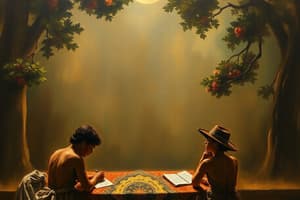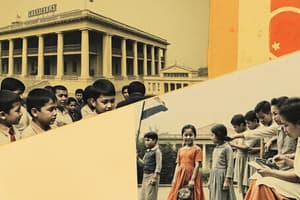Podcast
Questions and Answers
In precolonial Benguet, who led the oral tradition of passing down knowledge and skills?
In precolonial Benguet, who led the oral tradition of passing down knowledge and skills?
- Benguet's leaders
- Pang-amaen/am ama (elders) (correct)
- American colonizers
- Thomasites
What was the primary focus of the American teachers known as the Thomasites in Benguet's education system?
What was the primary focus of the American teachers known as the Thomasites in Benguet's education system?
- Promoting social institutions
- Establishing social classes
- Introduction of chalk and blackboards
- Introduction of the 'Three R's' – Reading, Writing, and Arithmetic (correct)
Which social institution is characterized by a distinct division into classes, with the wealthy and the poor?
Which social institution is characterized by a distinct division into classes, with the wealthy and the poor?
- Benguet society
- Kankanaey society
- Ikalahans society
- Ibaloy society (correct)
What is the Kankanaey's largest social unit?
What is the Kankanaey's largest social unit?
What is the term for the Ibaloy and Kankana-ey system of mutual and reciprocal work?
What is the term for the Ibaloy and Kankana-ey system of mutual and reciprocal work?
What is the Batares practice that involves gathering neighbors to help with heavy-labor projects?
What is the Batares practice that involves gathering neighbors to help with heavy-labor projects?
What is the Kankana-ey tradition that represents communal unity, helpfulness, and cooperation?
What is the Kankana-ey tradition that represents communal unity, helpfulness, and cooperation?
What is the Kalanguya traditional practice of voluntary service?
What is the Kalanguya traditional practice of voluntary service?
Study Notes
Educational Institutions in Benguet
- In precolonial times, education was based on oral tradition, where knowledge and skills were passed down through storytelling, chants, songs, and rituals led by pang-amaen/amama (elders).
- The American influence, through the Thomasites, revolutionized Benguet's education system, introducing the "Three R's" – Reading, Writing, and Arithmetic.
- The Thomasites employed an innovative "adult class mode delivery" method, conducting evening classes for adults who spent their days farming or engaging in other livelihood activities.
- Classes were taught using chalk and blackboards, under the light of the saleng and kerosene lamp, to teach adult learners how to read, write, and perform basic arithmetic.
Social Institutions in Benguet
- In Ibaloy society, there is a distinct division into classes, with the wealthy (baknang) and the poor (abitug).
- The Kankanaey's society is organized around the 'ili' or village, which is their largest social unit.
- For the Ikalahans, social structures are based largely on kinship, forming bilateral groups of kin for mutual support.
- The Aduyon/Alluyon system is a mutual and reciprocal work practice in Ibaloy and Kankana-ey cultures.
- The Khamal/Kamal practice involves gathering neighbors to help with heavy-labor projects, such as building a house or community projects, in the Batares culture.
- The Albubo tradition represents communal unity, helpfulness, and cooperation in Kankana-ey culture.
- The Dang-as/Da-ngah practice is a traditional voluntary service in Kalanguya culture.
Studying That Suits You
Use AI to generate personalized quizzes and flashcards to suit your learning preferences.
Description
Test your knowledge of Benguet's education system, from the precolonial oral tradition to the American influence of the Thomasites.




